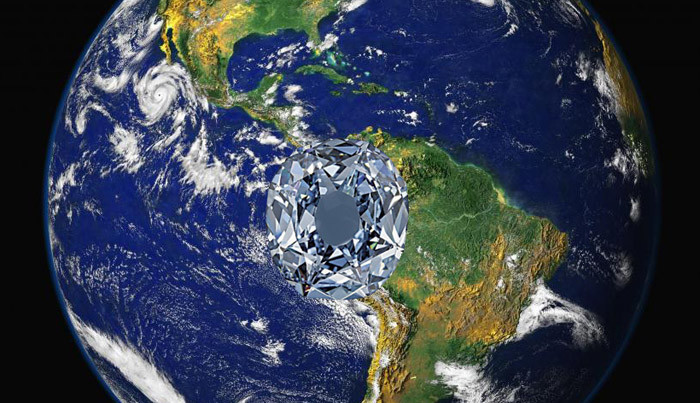Diamonds under the soles of her shoes
July 17, 2018
on
on

According to a new study by MIT, there are more than a quadrillion tons of diamonds stashed away in the Earth's interior. However unless you have mining equipment able to recover them from more than 100 miles below the earth’s surface you are unlikely to become a multi-billionaire overnight.
The study published this week suggests that deep rock layers known as cratons which lie below the centers of most continental plates may be made up of around 2 % diamond crystals. In the deepest parts of the cratons called the ‘roots’ the pressure and temperature is sufficient for carbon to crystallise into diamonds.
It would seem that diamond is not necessarily that exotic, in fact quite commonplace if you know where to look. Unfortunately at that depth it’s not going to be easy to recover. Ulrich Faul and his colleagues at MIT came to this conclusion after anomalies were indentified from studies of seismic data. In recent decades, several seismic events have been recorded, primarily consisting of sound wave of earthquakes, tsunamis, explosions and other violent events. By studying the wave shapes it’s possible to get an idea of the Earth's interior structure and its composition. Temperature, density and rock composition all influence the speed of sound.
The anomaly in the data was that sound waves sped up as they went through the roots of old cratons. The measured speeds were higher than predicted based on existing models of the earth’s internal structure.
The research team found only one composition of rock could support the speed measured: a material that contains 1 to 2 % diamond in addition to peridotite (the dominant rock type of the upper mantle) and small amounts of eclogite (which represents the subducted oceanic crust). This result indicates there is more than 1,000 times more diamond material present than had previously been expected. The hypothesis is not so surprising because diamond rough is known to occur at some sites associated with volcanic activity. Eruptions of Kimberlite igneous rock type (named after the city of Kimberley, South Africa, where the stone that was used to cut the large ‘Star of South Africa’ diamond was unearthed) are often found to contain diamonds.
The study published this week suggests that deep rock layers known as cratons which lie below the centers of most continental plates may be made up of around 2 % diamond crystals. In the deepest parts of the cratons called the ‘roots’ the pressure and temperature is sufficient for carbon to crystallise into diamonds.
It would seem that diamond is not necessarily that exotic, in fact quite commonplace if you know where to look. Unfortunately at that depth it’s not going to be easy to recover. Ulrich Faul and his colleagues at MIT came to this conclusion after anomalies were indentified from studies of seismic data. In recent decades, several seismic events have been recorded, primarily consisting of sound wave of earthquakes, tsunamis, explosions and other violent events. By studying the wave shapes it’s possible to get an idea of the Earth's interior structure and its composition. Temperature, density and rock composition all influence the speed of sound.
The anomaly in the data was that sound waves sped up as they went through the roots of old cratons. The measured speeds were higher than predicted based on existing models of the earth’s internal structure.
The research team found only one composition of rock could support the speed measured: a material that contains 1 to 2 % diamond in addition to peridotite (the dominant rock type of the upper mantle) and small amounts of eclogite (which represents the subducted oceanic crust). This result indicates there is more than 1,000 times more diamond material present than had previously been expected. The hypothesis is not so surprising because diamond rough is known to occur at some sites associated with volcanic activity. Eruptions of Kimberlite igneous rock type (named after the city of Kimberley, South Africa, where the stone that was used to cut the large ‘Star of South Africa’ diamond was unearthed) are often found to contain diamonds.
Read full article
Hide full article



Discussion (2 comments)
ROBERT ALEXANDER 6 years ago
Dr. Thomas Scherer 6 years ago